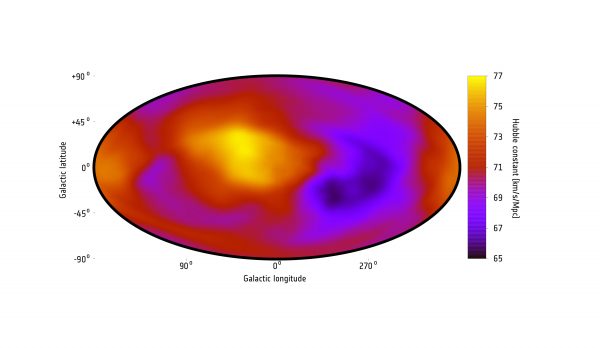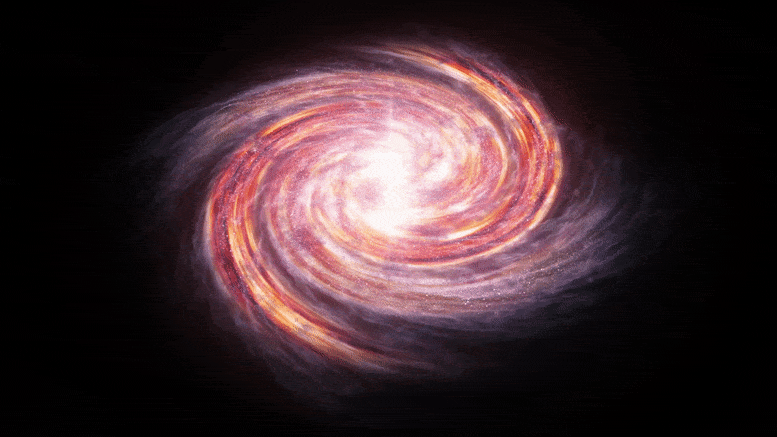Do We Live in a Lopsided Universe? – Scientific American
If your life sometimes seems directionless, you might legitimately blame the universe.
According to the key tenets of modern physics, the cosmos is “isotropic” at multi-billion-light-year scales—meaning it should have the same look and behavior in every direction. Ever since the big bang nearly 14 billion years ago, the universe ought to have expanded identically everywhere. And that expectation matches what astronomers see when they observe the smooth uniformity of the big bang’s all-sky afterglow: the cosmic microwave background (CMB). Now, however, an x-ray survey of distances to galaxy clusters across the heavens suggests some are significantly closer or farther away than isotropy would predict. This finding could be a sign that the universe is actually “anisotropic”—expanding faster in some regions than it does in others. With apologies to anyone seeking a cosmic excuse for personal woes, maybe the universe is not so directionless after all.
This possible evidence for anisotropy comes from an international team led by astronomer Konstantinos Migkas of the University of Bonn in Germany. And it relies on new or archival data on nearly 850 galaxy clusters seen by NASA’s Chandra X-ray Observatory, the European Space Agency’s XMM-Newton satellite and Japan’s Advanced Satellite for Cosmology and Astrophysics.
The study, which appeared in the April edition of Astronomy & Astrophysics, treats each cluster a bit like a lighthouse—gauging their distances by how bright or dim each one appears. By measuring the kinds and amounts of x-rays emitted by the hot, rarefied gas suffusing a given cluster, the team could determine that gas’s temperature. Doing so allowed the researchers to estimate the cluster’s x-ray luminosity—and therefore its distance. Next, they calculated each cluster’s luminosity via a separate technique that relied, in part, on preexisting determinations of the universe’s expansion rate. Comparing the two independent cluster luminosity values allowed Migkas and his colleagues to probe potential deviations in the universe’s rate of expansion across the entire sky, revealing two regions where clusters were some 30 percent brighter or fainter (and thus potentially closer or farther away) than expected.
“We managed to pinpoint a region that seems to expand slower than the rest of the universe and one that seems to expand faster,” Migkas says. “There are many studies with optical supernovae and with infrared galaxies that have detected similar anisotropies toward the same directions as well. And there are also many studies with similar data sets that do not show any anisotropies! Therefore, the situation is still vague. We do not argue to know the origin of the anisotropies, only that they are there.”

An Astonishing, Depressing Anisotropy
An anisotropic universe would shake the pillars of physics, demanding major revisions to current thinking about cosmic evolution. “If [the universe’s growth] is indeed different in different directions, that brings a whole new wrinkle into a cosmological assumption about homogeneity of the expansion over sufficiently large regions of space,” says Megan Donahue, a Michigan State University astrophysicist who was not involved in the study. A lopsided expansion “would be astonishing and depressing,” she adds, because it would suggest our understanding of the universe’s large-scale structure and evolution is profoundly—perhaps permanently—incomplete.
To explain such a thing—and to reconcile it with the nearly perfect isotropy seen in the CMB—cosmologists could turn to dark energy, the mysterious force driving an acceleration to the universe’s growth. Perhaps, somewhere in the intervening eons between the CMB’s picture of the “early” universe and the “late” one of the past several billion years, dark energy’s effects became stronger in some select parts of the cosmos, creating a lopsided expansion.
“It would be remarkable if dark energy were found to have different strengths in different parts of the universe,” said study co-author Thomas Reiprich of the University of Bonn in a recent statement. “However, much more evidence would be needed to rule out other explanations and make a convincing case.”
Alternatively, the universe might not be lopsided at all: the aberrant galaxy clusters could be caught up in a “bulk flow,” pulled out of place by the gravitational grip of even bigger and more distant clusters, a bit like boats swept along in a river’s swift currents. But most cosmologists have not expected bulk flows to occur across the extremely large scales probed by the study, which made measurements out to roughly five billion light-years.
“It could very well be a bulk flow,” Migkas says. “Nevertheless, this would be very important as well, simply because most studies do not take that into account! Any existing bulk flows could heavily affect our results and measurements if people do not correct for these motions appropriately.”
Cosmic Blind Spots
The most obvious explanation, of course, would be that the apparent asymmetries in cluster spacing are because of flaws in the data or their analysis. Yet that scenario could still demand updates to scientists’ understanding of how errors creep into their best reckonings of cosmic distances.
“Studies using clusters as probes of cosmology have been giving screwy results for a while,” says Adam Riess, an astronomer at Johns Hopkins University, who is unaffiliated with Migkas’s team, citing recent analyses by other researchers that highlight inconsistencies between cluster-based work and other measurement techniques. Such inconsistencies suggest correlations between a galaxy cluster’s x-ray temperature and its luminosity are not as clear-cut as researchers would prefer. Furthermore, Riess says, there are other potential problems to deal with right here in the Milky Way: namely, our galaxy’s gas-and-dust-filled disk, which obscures astronomers’ views of the wider cosmos in various vexing ways. It may not be coincidental, he says, that the region of greatest apparent cosmic anisotropy identified by Migkas and his colleagues borders the place where the Milky Way’s x-ray-absorbing gas and dust are thickest. “They are claiming the weird direction of the universe is right in our blind spot,” Riess adds. “That seems suspicious!”
David Spergel, a cosmologist at Princeton University and the Flatiron Institute in New York City, also suspects faults in the cluster-based measurements—in part because so many other techniques provide fundamentally conflicting results. “This is a paper that is very important if [it is] true but very unlikely to be true,” he says. “We have many much more accurate tests of anisotropy based on observations of [the CMB] and of large-scale structure. These observations are simpler, cleaner and have been reproduced in multiple different ways.” Anisotropies of the scale suggested by the new study, he says, would lead to fluctuations in the CMB that were 1,000 times brighter than what astronomers have observed.
Even so, Migkas and his colleagues argue that decisively ruling against—or for—a lopsided universe requires additional, more comprehensive probes of large-scale cosmic structure. They are now looking for further hints of galaxy-cluster anisotropy within maps of the CMB and seeking to validate their x-ray-based cluster studies with complementary infrared observations. Conclusive results could ultimately come from new space telescopes—such as eROSITA, a German-Russian x-ray observatory, or the European Space Agency’s upcoming Euclid mission—that will perform deeper and broader surveys of clusters across the entire sky.
“Generally, we believe that more and more people should look into the isotropy of the universe—finding new methods and tools to do so—considering the enormous significance this has for standard cosmology,” Migkas says. “It would be great if we knew, once and for all, if the late universe looks isotropic or not.”






